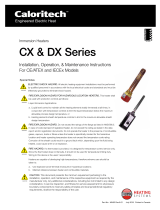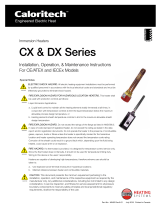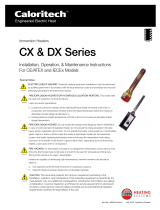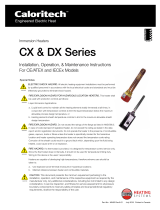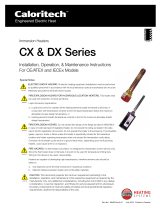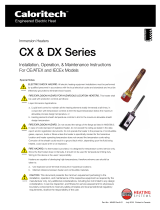
Type LTFX
Unitary Electric Immersion Heaters
© 2010 Chromalox, Inc.
Chromalox
®
DIVISION
4
SECTION
LTFX
SALES
REFERENCE
DATE
SERVICE REFERENCE
Installation, Operation
and
RENEWAL PARTS IDENTIFICATION
PN403-1
161-049178-101
SEPTEMBER, 2009
(Supersedes PN403)
Immersion ANSI Flange Number Tube Watt Density
Matching Control Panel
Heater Model kW Volts Phase Circuits Length (In.) Size of Tubes Diameter (Outside) PCN Model
LTFX-125-004E4 4 480 3 1 60 4" - 150# 1 2" 10 328858 4468-30211
LTFX-128-008E4 8 480 3 1 96 4" - 150# 1 2" 12 328858 4468-30211
LTFX-1212-012E4 12 480 3 1 144 4" - 150# 1 2" 12 328858 4468-30211
LTFX-2212-024E4 24 480 3 1 144 6" - 150# 2 2" 12 328858 4468-30211
LTFX-3212-036E4 36 480 3 1 144 6" - 150# 3 2" 12 328890 4468-30211
LTFX-2325-060E4 60 480 3 1 300 8" - 150# 2 3" 9 329920 4468-60211
LTFX-3325-090E4 90 480 3 3 300 10" - 150# 3 3" 9 N/A 4468-90211
LTFX-4325-120E4 120 480 3 2 300 10" - 150# 4 3" 9 N/A 4432-348-51100
LTFX-6325-180E4 180 480 3 3 300 12" - 150# 6 3" 9 N/A 4432-348-51100
LTFX-8325-240E4 240 480 3 4 300 14" - 150# 8 3" 9 N/A 4432-348-51100
Specifications — E4 Moisture Resistant Housing
Immersion ANSI Flange Number Tube Watt Density
Matching Control Panel
Heater Model kW Volts Phase Circuits Length (In.) Size of Tubes Diameter (Outside) PCN Model
LTFX-125-004E2 4 480 3 1 60 4" - 150# 1 2" 10
LTFX-128-008E2 8 480 3 1 96 4" - 150# 1 2" 12
LTFX-1212-012E2 12 480 3 1 144 4" - 150# 1 2" 12
LTFX-3210-024E2 24 480 3 1 120 8" - 150# 3 2" 9
LTFX-3215-036E2 36 480 3 1 180 8" - 150# 3 2" 9
LTFX-3225-060E2 60 480 3 1 300 8" - 150# 3 2" 9
LTFX-4225-090E2 90 480 3 2 300 10" - 150# 4 2" 10
LTFX-8215-120E2 120 480 3 2 180 12" - 150# 8 2" 12
LTFX-9220-180E2 180 480 3 3 240 14" - 150# 9 2" 11
LTFX-12225-240E2 240 480 3 4 300 14" - 150# 12 2" 9
Specifications — E2 Explosion/Moisture Resistant Housing
Note: Explosion Resistant
Control Panels are available.
However, locating the
control panel outside the
hazardous location may offer
significant cost savings.
Please refer to section 'H' of
the catalog for available
Panel options.
Note: For horizontal mount only.

WARNING: ELECTRIC SHOCK HAZARD. Disconnect
all power before installing or servicing heater.
Failure to do so could result in personal injury or
property damage. Heater must be installed or ser-
viced by a qualified person in accordance with the
National Electrical Code, NFPA 70.
ELECTRIC SHOCK HAZARD. Any installation involv-
ing electric heaters must be performed by a quali-
fied person and must be effectively grounded in
accordance with the National Electrical Code to
eliminate shock hazard.
The system designer is responsible for the safety
of this equipment and should install adequate
back-up controls and safety devices with their
electric heating equipment. Where the conse-
quences of failure could result in personal injury or
property damage, back-up controls are essential.
1. Electrical wiring to heating elements must be sized and installed in
accordance with the National Electric Code and applicable local
codes by a qualified person as defined in the NEC.
2. Temperatures at the heater terminals will require the use of man-
ganese nickel or equivalent temperature lead wire. (Type TGS,
TGT, or TGGT are recommended.)
DANGER: Hazard of Explosion or Fire. The tank must
be purged of all flammable vapors prior to cutting or
welding.
High heating efficiency, low element temperatures, and longer
heater life are achieved when the unit is properly installed.
1. To avoid chipping or cracking, precaution should be taken while
unpacking, handling, and installing the ceramic insulators. Heaters
with damaged insulators should be returned to the factory for repair or
replacement. Contact your local sales office for return authorization.
2. The LTFX unit must not be mounted in the vertical position as the
resistance wire on the OCE element can sag, thus causing uneven heat-
ing or short circuit. Unit should be installed in a horizontal position
with the thermowell on top only.
3. IMPORTANT: Mount heater in the tank so the liquid
level will always be above the effective heated portion
of the heater. Provide expansion tank if necessary.
4. Select a location for this installation according to the following guide-
lines: (refer to Figure 1)
A. Heating elements are removable through the terminal enclosure
however adequate room must be provided for this purpose. The
removal length of the OCE heating element is 3 feet since the cen-
ter section may be bent on a 12” radius. OCE elements should only
be bent in a vertical plane with ground strap on the bottom.
B. The neck on the tank’s mating flange should be of adequate length
to accommodate tank insulation and flange bolting.
5. Tube supports (internal to the tank) should be placed approximately
three feet from the ‘wet-side’ of the LTFX flange to ensure gasket seal-
ing integrity. Additional tube supports can then be spaced on 10 foot
centers. Do not anchor the heater tubes to the supports, as the tubes
must be allowed to expand.
6. To ensure proper sealing, a material appropriate gasket needs to be
installed between the mating flanges. The mating flanges should then
be secured by tightening the bolting according to TEMA Standards.
7. A tank suction pipe should be mounted at least 2” above the level of the
heaters. A separate line can be provided to drain tank after heaters have
been de-energized
.
INSTALLATION
2
Allow for Tank
Insulation and Bolting
36” Min. Element
Removal Distance
Model LTFX
Tank
Fluid
Level
Open-Coil Elements
Figure 1
The Chromalox Unitary Electric Immersion Heater, Model
LTFX, is an engineered, pretested package designed to give years
of virtually maintenance free service and it is shipped ready for
installation into a storage tank. LTFX provides low watt-density
heating over a large heating surface with precise temperature con-
trol for such materials as asphalt, fuel oil, pitch and tar, liquid
sugar, lube oils, linseed oil, biodiesel, glycerin, ethanol and many
other heat sensitive compounds.
The open coil heating elements (OCE) are housed in either 2”
or 3” Schedule 40 carbon or stainless steel pipes, which are weld-
ed into the 150# ANSI flange. Once the Unitary Immersion Heater
is mated to your tank, the heating elements may be removed and
replaced without draining the tank.
Since excessive temperatures may permanently damage the
heater and cause premature failure, the use of temperature con-
trols, limiting controls, and liquid level sensors are recommended.
The system designer is responsible for the safety
of this equipment and should install adequate
back-up controls and safety devices with their
electric heating equipment. Where the conse-
quences of failure could result in personal injury or
property damage, back-up controls are essential.
GENERAL
WIRING

WIRING (cont’d.)
Wiring Entrance Locations - Moisure Resistant Housing Only
(E4 Option)
The Moisture Resistant (E4) Housing offers several conve-
nient options for conduit wiring & location. The housing is
equipped with two removable service entrance plates for installa-
tion of wiring. Any or all of the six sides can be used for wiring
locations. Refer to exploded view drawing. The housing can also
be rotated (by removal from flange) to allow for more position
possibilities. To install service entrance holes, simply remove the
side Allen screws and use the centering depression to drill the
appropriate size hole. Reinstall the gasket(s), if applicable, and
service entrance plates by tightening the Allen head screws to 4-5
in-lbs. The 'Octobox' style of housing can be removed for ease of
access to element bussing or to better locate the power conduit(s)
entry point. To accomplish, simply remove the Allen-head screws
on the outside of the housing. When reinstalling, be sure to prop-
erly align gasket, if applicable, and tighten to 40-50 in-lbs.
Tip for Reinstalling Gaskets:
Place Allen Head screws through metal covers and gentle
push gasket hole over the threaded screw. This will allow the gas-
ket to stay in place while tightening the cover.
Wiring Entrance Locations - Explosion Resistant Housing
Only (E2 Option)
The Explosion Resistant (E2) Housing features dedicated
conduit connection sizes and locations for NPT installation of con-
duit. Wiring installation must be in accordance with Hazardous
Area requirements. The use of EYS seals or rigid conduit may be
required. Please consult with the local inspection authority.
Maximum Temperatures
Safe operation in a hazardous location requires the maximum
operating temperatures of all exposed surfaces of the heater
including temperatures on the outside of the vessel, piping,
flanges, screw plugs, enclosures and other heat conducting parts be
limited. The flammable liquids, vapors or gases present determine
the maximum surface temperature permitted in any hazardous
location. The end user or purchaser of the electric heating equip-
ment is responsible for determining the proper classification of an
area and for providing Chromalox with hazardous area specifica-
tions and requirements for proper equipment design. (NEC and
IEC provide guidelines for evaluating and classifying hazardous
locations.)
An approved liquid level control or overtemperature
control must be installed to deenergize the heater if
the liquid level drops below the top of the heater.
Heater kW Volts Phase Total Amps Circuits
LTFX-125-004E4 4 480 3 4.8 1
LTFX-128-008E4 8 480 3 9.6 1
LTFX-1212-012E4 12 480 3 14.5 1
LTFX-2212-024E4 24 480 3 28.9 1
LTFX-3212-036E4 36 480 3 43.4 1
LTFX-2325-060E4 60 480 3 72.3 1
LTFX-3325-090E4 90 480 3 108.4 3
LTFX-4325-120E4 120 480 3 144.5 2
LTFX-6325-180E4 180 480 3 216.8 3
LTFX-8325-240E4 240 480 3 289.0 4
Heater kW Volts Phase Total Amps Circuits
LTFX-125-004E2 4 480 3 4.8 1
LTFX-128-008E2 8 480 3 9.6 1
LTFX-1212-012E2 12 480 3 14.5 1
LTFX-3210-024E2 24 480 3 28.9 1
LTFX-3215-036E2 36 480 3 43.4 1
LTFX-3225-060E2 60 480 3 72.3 1
LTFX-4225-090E2 90 480 3 108.4 2
LTFX-8215-120E2 120 480 3 144.5 2
LTFX-9220-180E2 180 480 3 216.8 3
LTFX-12225-240E2 240 480 3 289.0 4
Table B – E2 Wiring Information
Table A – E4 Wiring Information
OPERATION
FIRE HAZARD. To avoid possible damage to the
heater, do not energize until the tank is filled with
fluid. Recommended fluid level is 2” above the heater
tube or pipe.
1. Do not operate heaters at voltages in excess of that stamped on the
heater, since excess voltage will shorten heater life.
2. Heaters should not be operated in environments with factors that
can destroy the electrical insulating characteristics of the ceramic
insulators. Foreign contaminants can create leakage (shock) haz-
ards, permanent heater damage, or cause heater failure and there-
fore should be avoided.
For initial operation and tuning the control scheme:
1. Turn the master circuit breaker off and open the control box door.
2. Set the indicating temperature control at the desired temperature
and the over-temperature cutout at 50°F above this temperature.
3. Interlock the liquid level control with the cutout device.
4. Close the control box door and turn the circuit breaker on. To ener-
gize the heater circuits, turn the on-off selector switch to the “on”
position.

Table C – E4 Housing Renewal Parts Identification
Table D – E2 Housing Renewal Parts Identification
TA - S7 - EF.
Litho in U.S.A.
2150 N. RULON WHITE BLVD., OGDEN, UT 84404
Phone: 1-800-368-2493 www.chromalox.com
TYPE LTFX RENEWAL PARTS IDENTIFICATION
Heater Immersion ANSI Number Tube OCE Replacement
Model kW Volts Phase Length (In.) Flange Size of Tubes Diameter Element No. OCE Model No.
LTFX-125-004E4 4 480 3 60 4" - 150# 1 2" #1 OCE-05040-2-483
LTFX-128-008E4 8 480 3 96 4" - 150# 1 2" #2 OCE-06080-2-483
LTFX-1212-012E4 12 480 3 144 4" - 150# 1 2" #3 OCE-12120-2-483
LTFX-2212-024E4 24 480 3 144 6" - 150# 2 2" #3 OCE-12120-2-483
LTFX-3212-036E4 36 480 3 144 6" - 150# 3 2" #3 OCE-12120-2-483
LTFX-2325-060E4 60 480 3 300 8" - 150# 2 3" #4 OCE-25300-3-483
LTFX-3325-090E4 90 480 3 300 10" - 150# 3 3" #4 OCE-25300-3-483
LTFX-4325-120E4 120 480 3 300 10" - 150# 4 3" #4 OCE-25300-3-483
LTFX-6325-180E4 180 480 3 300 12" - 150# 6 3" #4 OCE-25300-3-483
LTFX-8325-240E4 240 480 3 300 14" - 150# 8 3" #4 OCE-25300-3-483
Heater Immersion ANSI Number Tube OCE Replacement
Model kW Volts Phase Length (In.) Flange Size of Tubes Diameter Element No. OCE Model No.
LTFX-125-004E2 4 480 3 60 4" - 150# 1 2" #1 OCE-05040-2-483
LTFX-128-008E2 8 480 3 96 4" - 150# 1 2" #2 OCE-06080-2-483
LTFX-1212-012E2 12 480 3 144 4" - 150# 1 2" #3 OCE-06080-2-483
LTFX-3210-024E2 24 480 3 120 8" - 150# 3 2" #2 OCE-06080-2-483
LTFX-3215-036E2 36 480 3 180 8" - 150# 3 2" #3 OCE-06080-2-483
LTFX-3225-060E2 60 480 3 300 8" - 150# 3 2" #5 OCE-25200-2-4803
LTFX-4225-090E2 90 480 3 300 10" - 150# 4 2" #6 OCE-25225-2-4803
LTFX-8215-120E2 120 480 3 180 12" - 150# 8 2" #7 OCE-15150-2-4803
LTFX-9220-180E2 180 480 3 240 14" - 150# 9 2" #5 OCE-25200-2-4803
LTFX-12225-240E2 240 480 3 300 14" - 150# 12 2" #5 OCE-25200-2-4803
MAINTENANCE
ELECTRIC SHOCK HAZARD. Disconnect all power
before installing or servicing heater. Failure to do
so could result in personal injury or property dam-
age. Heater must be installed or serviced by a
qualified person in accordance with the National
Electrical Code, NFPA 70.
1. Make certain both the terminals and the ceramic insulators are free
from contact with oil, liquid, or other foreign matter.
NOTE: Chromalox cannot be responsible for failures or damage
caused by contamination on the ceramic insulators. Make certain the
heaters are not exposed to contaminants.
2. Check electrical connections at heater terminals and tighten if neces-
sary. This will help avoid hot terminals which may destroy wire insu-
lation or heater terminals
3. Check overheat operation to assure heater protection.
Element Replacement - Moisture Resistant Housing Only
(E4 Option)
1. To remove the OCE heating elements, first turn the circuit breaker to
the off position.
2. Next remove the housing lid, element wiring and the element mount-
ing screw. Now pull the element straight out of the heating tube.
NOTE: OCE elements should only be bent in a vertical plane with
ground strap on the bottom.
3. When removing the heating elements, make certain that the terminals
and the ceramic insulators do not contact oil or any other liquid foreign
matter. NOTE: Chromalox cannot be responsible for failures or dam-
age caused by contamination on the ceramic insulators.
4. Installation is the reverse of the above.
Element Replacement - Hazardous Locations, Explosion Resistant
Housing Only (E2 option)
1. To remove the OCE heating assembly, first turn the circuit breaker to
the off position.
2. Next remove the housing lid, element wiring, and 5/16” bolting around
the element flamepath module. If needed, (2) 1/4-20x2” bolts may be
used to break loose the module from the flange. Turn bolts evenly until
module is free. The flamepath module will be re-used, so disconnected
the heating element from the module pins. Now pull the element
assembly out of the heating tube. NOTE: OCE elements should only be
bent in a vertical plane with ground strap on the bottom.
3. When removing the heating elements, make certain that the terminals
and the ceramic insulators do not contact oil or any other liquid foreign
matter. Note: Chromalox cannot be responsible for failures or damage
caused by contamination on the ceramic insulators.
4. Inspect the element assembly flange and mating surface for any debris,
oils, or contamination. NOTE: Surfaces must be in suitable condition
to ensure proper hazardous rating.
5. Connect the new element to the flamepath module and slide into tube.
Flamepath module bolting must be tightened to XXX ft. lbs. of torque.
6. Reattach element wiring. When reinstalling housing lid, be sure to prop-
erly align gasket, and tighten housing bolts to 40-50 in-lbs.
Limited Warranty:
Please refer to the Chromalox limited warranty applicable to this product at
http://www.chromalox.com/customer-service/policies/termsofsale.aspx.
/
